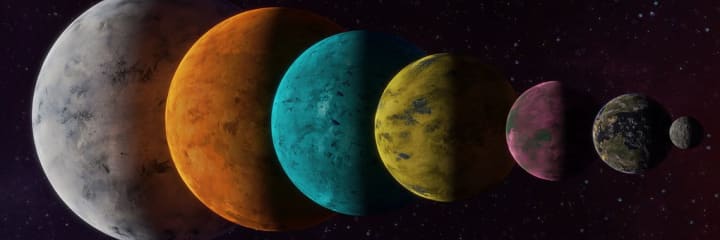
For centuries, humans have been fascinated by the possibility of life beyond our own planet. While we have yet to find conclusive evidence of extraterrestrial life, recent discoveries of exoplanets - planets that orbit stars other than our sun - have given us reason to hope. In this article, we will explore what exoplanets are, how they are detected, and how common potentially habitable exoplanets are in our galaxy.
What are exoplanets?
Exoplanets are planets that orbit stars other than our sun. They come in a wide range of sizes, from small, rocky planets to giant gas giants like Jupiter. Exoplanets are also found in a wide range of distances from their host stars, which affects their temperature and composition.

How do we detect exoplanets?
Detecting exoplanets is a challenging task since they are much dimmer than the stars they orbit. However, scientists have developed several methods for detecting exoplanets:
1. Transit Method:
The transit method involves observing the dip in the brightness of a star as a planet passes in front of it. By measuring the amount of light blocked by the planet, scientists can determine its size and orbital period.
2. Radial Velocity Method:
The radial velocity method involves measuring the wobbling of a star caused by the gravitational pull of an orbiting planet. By analyzing the star's motion, scientists can determine the planet's mass and orbital period.
3. Direct Imaging Method:
The direct imaging method involves taking a picture of the exoplanet directly. This method is challenging because exoplanets are much dimmer than their host stars, and their light can be drowned out by the star's glare.
4. Gravitational Microlensing Method:
The gravitational microlensing method involves observing the bending of light from a background star caused by the gravitational pull of a foreground star with an orbiting planet. By analyzing the light curve, scientists can determine the planet's mass and orbital period.
5. Astrometry Method:
The astrometry method involves measuring the tiny wobble of a star caused by the gravitational pull of an orbiting planet. This method is challenging because the wobble is very small, and it can be difficult to separate from other sources of motion.
How common are potentially habitable exoplanets in our galaxy?
Potentially habitable exoplanets are planets that orbit in the habitable zone of their host star, where temperatures are just right for liquid water to exist on the surface. Liquid water is considered a key ingredient for life as we know it. Scientists have detected several potentially habitable exoplanets using the methods described above.
According to the most recent data, it is estimated that there may be billions of potentially habitable exoplanets in our Milky Way galaxy alone. This means that the chances of finding extraterrestrial life may be higher than previously thought. However, it is important to remember that the conditions for life are complex and depend on many factors, such as the planet's atmosphere and the presence of other chemical compounds.
In addition to potentially habitable exoplanets, scientists have also discovered a wide variety of exoplanets that have pushed the boundaries of our understanding of planetary systems. These include exoplanets with multiple suns, exoplanets with wildly elliptical orbits, and exoplanets with extreme temperature variations.
Founded exoplanets
There have been thousands of exoplanets discovered so far, so here are just a few examples of some notable discoveries:
Proxima Centauri b:
This planet is located in the habitable zone of the closest star to our solar system, Proxima Centauri. It is a rocky planet with a mass similar to Earth and has the potential to have liquid water on its surface.
TRAPPIST-1 system:
This system has seven Earth-sized planets, all of which are located in the habitable zone of the star. Three of the planets are thought to have the potential for liquid water on their surface.
Kepler-186f:
This was the first Earth-sized exoplanet discovered in the habitable zone of its star. It is located about 500 light-years away from Earth.
HD 209458 b:
This is one of the first exoplanets discovered, and it was the first to have its atmosphere detected. It is a gas giant planet that orbits very close to its star, so its atmosphere is being evaporated.
WASP-121b:
This planet is a "hot Jupiter" because it is a gas giant planet that orbits very close to its star. It has been found to have a stratosphere, which is a layer of the atmosphere where temperatures increase with altitude.
51 Pegasi b:
This was the first exoplanet discovered orbiting a sun-like star. It is a "hot Jupiter" and orbits very close to its star, completing a revolution in just over four days.
Kepler-438b:
This planet is located in the habitable zone of its star and has a similar size and composition to Earth. However, it receives about 40% more light than Earth, which makes it unlikely to be habitable.
GJ 1214 b:
This is a "super-Earth" planet that is about 2.7 times the size of Earth. It is located about 40 light-years away from Earth and is believed to have a thick atmosphere, which may contain water vapor.
Kepler-22b:
This planet is located about 600 light-years away from Earth and is about 2.4 times the size of Earth. It is located in the habitable zone of its star, and its discovery sparked excitement about the potential for finding more habitable exoplanets.
HD 219134 b:
This planet is located about 21 light-years away from Earth and is about 1.6 times the size of Earth. It orbits very close to its star, completing a revolution in just three days.
These discoveries and many others have revealed the incredible diversity of exoplanets in our galaxy. They have also provided us with important insights into the formation and evolution of planetary systems. As technology continues to improve, it is likely that we will discover even more exoplanets, and we may one day find a planet that is truly Earth-like and potentially habitable.
Final thoughts
In conclusion, the discovery of exoplanets has revolutionized our understanding of the universe and our place in it. While the search for life beyond our own planet is still ongoing, the detection of potentially habitable exoplanets has given us reason to hope. By continuing to study exoplanets and their host stars, we can gain a better understanding of how planetary systems form and evolve over time.
Future missions such as the James Webb Space Telescope and the European Space Agency's PLATO mission are expected to discover even more exoplanets and potentially habitable worlds. These missions will also provide more detailed information about the atmospheres and compositions of these planets, which can help us determine their habitability and the likelihood of finding life.
The discovery of exoplanets also raises important questions about the nature of life in the universe and our place in it. Are we alone in the universe, or is life more common than we previously thought? How did life on Earth originate, and could similar processes be occurring on other planets? These are questions that scientists and philosophers will continue to grapple with in the coming years and decades.
In addition to the scientific and philosophical implications of exoplanet research, there are also practical applications. For example, studying exoplanets can help us better understand the formation and evolution of our own solar system. It can also help us develop new technologies for space exploration and colonization.
Overall, the discovery of exoplanets is a testament to the power of human curiosity and the potential of scientific inquiry. As we continue to explore the cosmos, we may one day find answers to some of our deepest questions about the universe and our place in it.
About the Creator
Gokila
She is an astrophile, introvert,
loves to read books all day long,
addicts in healthy lifestyle
and having curiosity to know about new things.
Life Is As Beautiful As You Make It. Contentment Is The Key To Happiness. Peace Be Upon The Saviour.






Comments (1)
Thank you for the insights ✨❤️💯😉👍